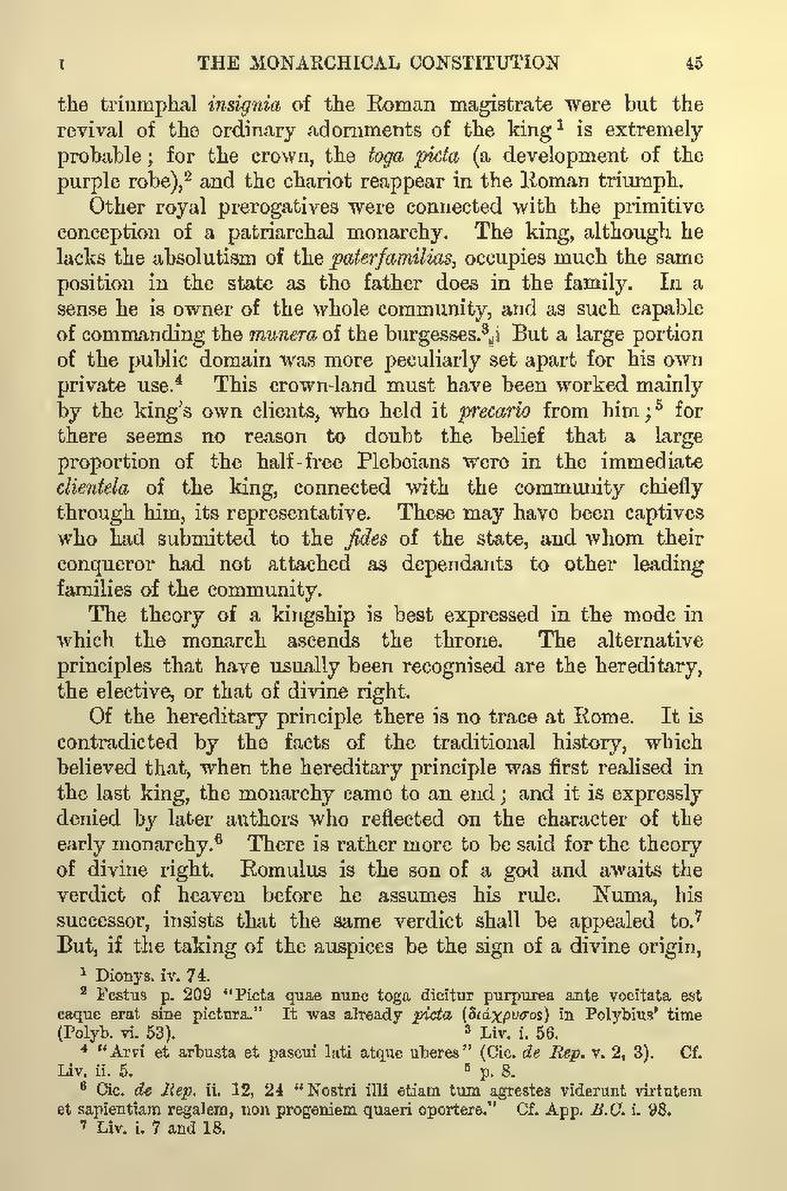the triumphal insignia of the Roman magistrate were but the revival of the ordinary adornments of the king[1] is extremely probable; for the crown, the toga picta (a development of the purple robe),[2] and the chariot reappear in the Roman triumph.
Other royal prerogatives were connected with the primitive conception of a patriarchal monarchy. The king, although he lacks the absolutism of the paterfamilias, occupies much the same position in the state as the father does in the family. In a sense he is owner of the whole community, and as such capable of commanding the munera of the burgesses.[3] But a large portion of the public domain was more peculiarly set apart for his own private use.[4] This crown-land must have been worked mainly by the king's own clients, who held it precario from him;[5] for there seems no reason to doubt the belief that a large proportion of the half-free Plebeians were in the immediate clientela of the king, connected with the community chiefly through him, its representative. These may have been captives who had submitted to the fides of the state, and whom their conqueror had not attached as dependants to other leading families of the community.
The theory of a kingship is best expressed in the mode in which the monarch ascends the throne. The alternative principles that have usually been recognised are the hereditary, the elective, or that of divine right.
Of the hereditary principle there is no trace at Rome. It is contradicted by the facts of the traditional history, which believed that, when the hereditary principle was first realised in the last king, the monarchy came to an end; and it is expressly denied by later authors who reflected on the character of the early monarchy.[6] There is rather more to be said for the theory of divine right. Romulus is the son of a god and awaits the verdict of heaven before he assumes his rule. Numa, his successor, insists that the same verdict shall be appealed to.[7] But, if the taking of the auspices be the sign of a divine origin,) in Polybius' time (Polyb. vi. 53).]
- ↑ Dionys. iv. 74.
- ↑ Festus p. 209 "Picta quae nunc toga dicitur purpurea ante vocitata est eaque erat sine pictura." It was already picta ([Greek: diachrysos
- ↑ Liv. i. 56.
- ↑ "Arvi et arbusta et pascui lati atque uberes" (Cic. de Rep. v. 2, 3). Cf. Liv. ii. 5.
- ↑ p. 8.
- ↑ Cic. de Rep. ii. 12, 24 "Nostri illi etiam turn agrestes viderunt virtutem et sapientiam regalem, non progeniem quaeri oportere." Cf. App. B.C. i. 98.
- ↑ Liv. i. 7 and 18.
